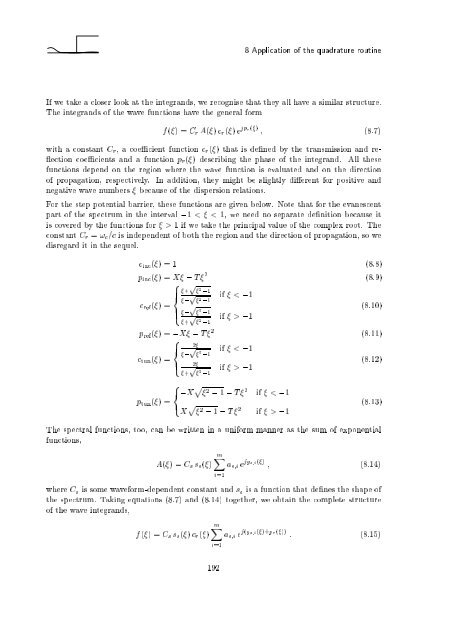Wave Propagation in Linear Media | re-examined
Wave Propagation in Linear Media | re-examined
Wave Propagation in Linear Media | re-examined
You also want an ePaper? Increase the reach of your titles
YUMPU automatically turns print PDFs into web optimized ePapers that Google loves.
8 Application of the quadratu<strong>re</strong> rout<strong>in</strong>e<br />
If we take a closer look at the <strong>in</strong>tegrands, we <strong>re</strong>cognise that they all have a similar structu<strong>re</strong>.<br />
The <strong>in</strong>tegrands of the wave functions have the general form<br />
f( )=CrA( )cr( )e jpr( ) ; (8.7)<br />
with a constant Cr, a coe cient function cr( ) that is de ned by the transmission and <strong>re</strong>ection<br />
coe cients and a function pr( ) describ<strong>in</strong>g the phase of the <strong>in</strong>tegrand. All these<br />
functions depend on the <strong>re</strong>gion whe<strong>re</strong> the wave function is evaluated and on the di<strong>re</strong>ction<br />
of propagation, <strong>re</strong>spectively. In addition, they might be slightly di e<strong>re</strong>nt for positive and<br />
negative wavenumbers because of the dispersion <strong>re</strong>lations.<br />
For the step potential barrier, these functions a<strong>re</strong> given below. Note that for the evanescent<br />
part of the spectrum <strong>in</strong> the <strong>in</strong>terval ,1 < 1ifwe take the pr<strong>in</strong>cipal value of the complex root. The<br />
constant Cr = !c=c is <strong>in</strong>dependent of both the <strong>re</strong>gion and the di<strong>re</strong>ction of propagation, so we<br />
dis<strong>re</strong>gard it <strong>in</strong> the sequel.<br />
c<strong>in</strong>c( )=1 (8.8)<br />
p<strong>in</strong>c( )=X , T 2<br />
c <strong>re</strong>f( )=<br />
8<br />
><<br />
>:<br />
p<br />
+ 2,1<br />
, p 2 ,1<br />
, p 2 ,1<br />
p<br />
+ 2,1<br />
p <strong>re</strong>f( )=,X , T 2<br />
ctun( )=<br />
ptun( )=<br />
8<br />
><<br />
>:<br />
8<br />
<<br />
:<br />
2<br />
, p 2 ,1<br />
2 p<br />
+ 2,1<br />
if ,1<br />
if ,1<br />
,X p 2 ,1,T 2 if ,1<br />
(8.9)<br />
(8.10)<br />
(8.11)<br />
(8.12)<br />
(8.13)<br />
The spectral functions, too, can be written <strong>in</strong> a uniform manner as the sum of exponential<br />
functions,<br />
A( )=Csss( )<br />
mX<br />
i=1<br />
as;i e jgs;i( ) ; (8.14)<br />
whe<strong>re</strong> Cs is some waveform-dependent constant and ss is a function that de nes the shape of<br />
the spectrum. Tak<strong>in</strong>g equations (8.7) and (8.14) together, we obta<strong>in</strong> the complete structu<strong>re</strong><br />
of the wave <strong>in</strong>tegrands,<br />
f( )=Csss( )cr( )<br />
mX<br />
i=1<br />
192<br />
as;i e j(gs;i( )+pr( )) : (8.15)












